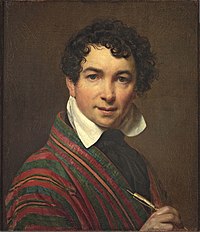Loading AI tools
Russian portrait painter (1782–1836) From Wikipedia, the free encyclopedia
Orest Adamovich Kiprensky (Russian: Орест Адамович Кипренский 24 March [O.S. 13 March] 1782 – 17 October [O.S. 5 October] 1836) was a leading Russian portraitist in the Age of Romanticism. His most familiar work is probably his portrait of Alexander Pushkin (1827), which prompted the poet to remark that "the mirror flatters me."
This article needs additional citations for verification. (December 2021) |
Orest Kiprensky | |
|---|---|
 Self Portrait, 1828 | |
| Born | Orest Adamovich Kiprensky 24 March 1782 |
| Died | 17 October 1836 (aged 54) |
| Resting place | Sant'Andrea delle Fratte, Rome |
| Nationality | Russian |
| Education | Member Academy of Arts (1812) |
| Alma mater | Imperial Academy of Arts (1803) |
| Known for | Painting |
| Notable work |
|
| Movement | Romanticism |
| Spouse |
Anna Maria Falcucci (m. 1836) |
| Awards | |
Orest was born in the village of Nezhnovo in the Saint Petersburg Governorate on 24 March [O.S. 13 March] 1782.[1] He was an illegitimate son of a landowner Alexey Dyakonov, hence his name, derived from Kypris, one of the Greek names for the goddess of love. He was raised in the family of Adam Shvalbe, a serf. Although Kiprensky was born a serf, he was released from the serfdom upon his birth and later his father helped him to enter a boarding school at the Imperial Academy of Arts in Saint Petersburg in 1788 (when Orest was only six years old).
He studied at the boarding school and the academy itself until 1803. He lived at the academy for three more years as a pensioner to fulfill requirements necessary to win the Major Gold medal. Winning the first prize for his work Prince Dmitri Donskoi after the Battle of Kulikovo (1805) enabled the young artist to go abroad to study art in Europe.
A year before his graduation, in 1804, he painted the portrait of Adam Shvalbe, his foster father (1804), which was a great success. The portrait so impressed his contemporaries, that later members of the Naples Academy of Arts took it for the painting by some Old Master – Rubens or van Dyck. Kiprensky had to ask the members of the Imperial Academy of Arts for letters supporting his authorship.
After that, Kiprensky lived in Moscow (1809), Tver 1811, Saint Petersburg 1812, in 1816–1822 he lived in Rome and Napoli. In Italy he met a local girl Anna Maria Falcucci (Mariucci), to whom he became attached. He bought her from her dissolute family and employed as his ward. On leaving Italy, he sent her to a Roman Catholic convent.
In 1828, Kiprensky came back to Italy, as he got a letter from his friend Samuil Galberg, informing him that they had lost track of Mariucci. Kiprensky found Mariucci, who had been transferred to another convent. In 1836 he eventually married her. He had to convert into Roman Catholicism from Russian Orthodoxy for this marriage to happen. He died by pneumonia in Rome later that year. He's been interred into the church of Sant'Andrea delle Fratte.[2]
Seamless Wikipedia browsing. On steroids.
Every time you click a link to Wikipedia, Wiktionary or Wikiquote in your browser's search results, it will show the modern Wikiwand interface.
Wikiwand extension is a five stars, simple, with minimum permission required to keep your browsing private, safe and transparent.